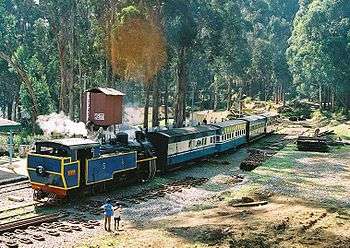Track gauge in India
.svg.png)
Indian Railways currently has four different gauges: the 1,676 mm (5 ft 6 in) broad gauge, the 1,000 mm (3 ft 3 3⁄8 in) metre gauge, and two narrow gauges 2 ft 6 in (762 mm) and 2 ft (610 mm). The total track length used by Indian Railways is 115,000 km (71,000 mi) while the total route length of the network is 66,030 km (41,030 mi) in 2015.[1]
Urban rail transit lines which serve the urban areas are being built in standard gauge. These encompass metro, monorail and trams. These lines are not owned by Indian Railways.[2]
Project Unigauge was started in 1991 that seeks to standardise the rail gauges in India by converting almost all of the metre gauge and narrow gauge tracks to broad gauge track. Few metre gauge and narrow gauge tracks on which heritage trains run in hilly regions like Shimla, Darjeeling, Ooty and Matheran would not be converted into broad gauge.[3]
Broad Gauge
The broad gauge line is the most widely used in India with approximately 108,500 km (67,400 mi) of track length and 60,430 km (37,549 mi) of route length in 2016.[4] It is also called Indian gauge and is the broadest gauge in operation in the world. The first railway line built in India was broad gauge line from Bori Bunder (now Chhatrapati Shivaji Terminus) to Thane in 1853.
Standard Gauge
In India, standard gauge is used only for urban rail transit systems such as metro, monorail and trams. Until 2010, the only standard gauge line in India was the Kolkata (Calcutta) tram system. All the upcoming metro lines in the urban areas would be built only in standard gauge as it is easier to acquire rolling stock for standard gauge than for Indian gauge.[5] As of 2016, lines in operation are Delhi Metro, Rapid MetroRail Gurgaon, the Bangalore Metro and the Mumbai Metro. All of these are operated separately from Indian Railways.
Metre Gauge

1,000 mm (3 ft 3 3⁄8 in) metre gauge lines were introduced to reduce the cost. Also, simpler engineering permitted sharp turns in hilly regions. All the metre gauge lines except the heritage Nilgiri Mountain Railway would be converted to broad gauge as part of Project Unigauge.[6]
Narrow Gauge

India has two different narrow gauge systems, 2 ft 6 in (762 mm) and 2 ft (610 mm). Narrow gauge lines were also constructed for cost considerations, and because simpler engineering permitting sharp turns in hilly regions. All the narrow gauge lines except heritage lines Kalka–Shimla Railway, Darjeeling Himalayan Railway and Matheran Hill Railway would be converted to broad gauge as part of Project Unigauge.[7]
References
- ↑ compiled and edited by Research, Reference and Training Division. (2011). "Table 19.1". India Yearbook 2011. Publications Division, Ministry of Information & Broadcasting, Govt. of India. ISBN 978-81-230-1674-0.
- ↑ Metro railways opt for standard gauge
- ↑ Project Unigauge
- ↑ Press Information Bureau
- ↑ Metro railways opt for standard gauge
- ↑ Project Unigauge
- ↑ Project Unigauge